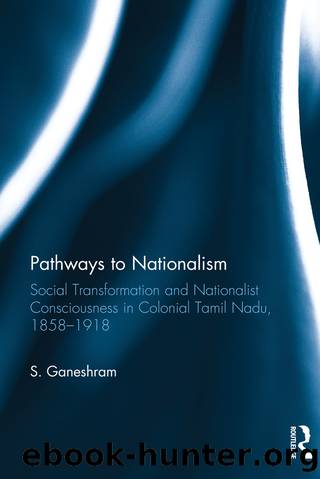Pathways to Nationalism by S. Ganeshram

Author:S. Ganeshram [Ganeshram, S.]
Language: eng
Format: epub
Tags: Social Science, Ethnic Studies, General, Regional Studies
ISBN: 9781351997362
Google: Q2IPDQAAQBAJ
Publisher: Routledge
Published: 2016-09-13T04:30:10+00:00
WIDOW REMARRIAGE MOVEMENT
The marriage of widows among Hindus was prohibited by long-established custom. Second marriages were wholly unknown to the Hindu law, but the practice of widow remarriage was common among the lower castes.61 The widows were not treated on par with other women and they had to follow many restrictions like not wearing ornaments, not consuming normal diet, tonsuring their heads, etc.62 It is due to the practice of child marriage, there were a growing number of child widows. Many female children became widows before they could even speak or walk.63 Thus, child marriage along with other factors, such as polygamy and old men marrying very young girls, were the main reasons for widowhood in India.64 The problem of widows and particularly of child widows was largely a custom of the higher strata of the Hindu society among whom the institution of child marriage was practised and remarriage prohibited. In the lower rungs of the society like Kallars, Maravars, Agamudayars and other communities, the practice of re-marriage was usual and very common.65 Further, until 1856, the remarriage of any widow had no legal sanction. By Hindu law, Hindu widows with certain exceptions were held, by reason of having been once married, incapable of contracting a second valid marriage, and the offspring of such widows by any second marriage were held illegitimate and incapable of inheriting property.66 This law prevented legally the widows from remarrying as it would not help to have property right. Thus, widowhood in India was enforced not only by social rigidity but also the absence of legal sanction for remarriage of widows.
To break this social custom, the first attempt was made by reformers of Bengal. Under the leadership of Ishvarchandar Yidyasagar, the 'Hindu Inhabitants of the Province of Bengal' submitted a petition to the Legislative Council of India in October 1855. The petitioners contended that the custom of enforced widowhood was not in accordance with the shastras or with true interpretation of Hindu law. They urged the legislature to pass a law to remove all legal obstacles to the marriage of Hindu widows and to declare the issues of all such marriages as legitimate.67 In response to the social reform agitation organized by Yidyasagar, the colonial government enacted the Hindu Widows Remarriage Act in 1856.68 The act was a success for the early social reformers as it removed all legal obstacles to the marriage of Hindu widows. However, the act remained a dead letter for a long time due to social rigidity. For instance in 1858, the Government of Madras made a survey of the operation of the Act in the Presidency. All district Magistrates in Tamil Nadu and the Police Commissioner of Madras city with one exception reported that the Act did not have any practical effect and no instance of remarriage had been brought to their notice in their districts since the promulgation.69 An exception to this general trend occurred in Salem district. In this case, a widow of 13 years old widow, the
Download
This site does not store any files on its server. We only index and link to content provided by other sites. Please contact the content providers to delete copyright contents if any and email us, we'll remove relevant links or contents immediately.
| Africa | Americas |
| Arctic & Antarctica | Asia |
| Australia & Oceania | Europe |
| Middle East | Russia |
| United States | World |
| Ancient Civilizations | Military |
| Historical Study & Educational Resources |
The Sympathizer by Viet Thanh Nguyen(4100)
The Rape of Nanking by Iris Chang(4027)
World without end by Ken Follett(3348)
Ants Among Elephants by Sujatha Gidla(3282)
Blood and Sand by Alex Von Tunzelmann(3061)
Japanese Design by Patricia J. Graham(3008)
City of Djinns: a year in Delhi by William Dalrymple(2438)
Foreign Devils on the Silk Road: The Search for the Lost Treasures of Central Asia by Peter Hopkirk(2393)
Inglorious Empire by Shashi Tharoor(2349)
The Queen of Nothing by Holly Black(2329)
India's Ancient Past by R.S. Sharma(2307)
In Order to Live: A North Korean Girl's Journey to Freedom by Yeonmi Park(2305)
Tokyo by Rob Goss(2295)
India's biggest cover-up by Dhar Anuj(2251)
Tokyo Geek's Guide: Manga, Anime, Gaming, Cosplay, Toys, Idols & More - The Ultimate Guide to Japan's Otaku Culture by Simone Gianni(2245)
The Great Game: On Secret Service in High Asia by Peter Hopkirk(2232)
Goodbye Madame Butterfly(2165)
Batik by Rudolf Smend(2010)
Living Silence in Burma by Christina Fink(1990)
